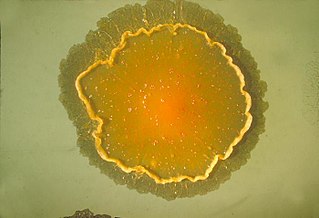Related Research Articles
The halophiles, named after the Greek word for "salt-loving", are extremophiles that thrive in high salt concentrations. While most halophiles are classified into the domain Archaea, there are also bacterial halophiles and some eukaryotic species, such as the alga Dunaliella salina and fungus Wallemia ichthyophaga. Some well-known species give off a red color from carotenoid compounds, notably bacteriorhodopsin. Halophiles can be found in water bodies with salt concentration more than five times greater than that of the ocean, such as the Great Salt Lake in Utah, Owens Lake in California, the Urmia Lake in Iran, the Dead Sea, and in evaporation ponds. They are theorized to be a possible analogues for modeling extremophiles that might live in the salty subsurface water ocean of Jupiter's Europa and similar moons.

Mycobacterium marinum is a slow growing mycobacterium (SGM) belonging to the genus Mycobacterium and the phylum Actinobacteria. The strain marinum was first identified by Aronson in 1926 and it is observed as a pathogenic mycobacterium. For example, tuberculosis like infections in fish (mycobacteriosis) and skin lesions in humans.

Synechococcus is a unicellular cyanobacterium that is very widespread in the marine environment. Its size varies from 0.8 to 1.5 µm. The photosynthetic coccoid cells are preferentially found in well–lit surface waters where it can be very abundant. Many freshwater species of Synechococcus have also been described.
Neptunomonas concharum is a species of bacteria. It is Gram-negative, facultatively anaerobic, motile and rod-shaped, its type strain being LHW37T. This species was first isolated from a dead ark clam, hence the specific epithet "concharum", meaning "of the shells".
Psychrobacter arcticus is a Gram-negative, nonmotile species of bacteria first isolated from Siberian permafrost. Its type strain is 273-4T.
Thermocrinis albus is a bacterium. Its type strain is HI 11/12.
Thermotoga hypogea is a hyperthermophilic organism that is a member of the order Thermotogales. It is thermophilic, xylanolytic, glucose-fermenting, strictly anaerobic and rod-shaped. The type strain of T. hypogea is SEBR 7054.
Streptomyces thermocarboxydus is a streptomycete bacterium species. It is moderately thermophilic and carboxydotrophic, with type strain AT37.
Methanothermobacter marburgensis is a thermophilic and obligately autotrophic archaeon. Its type strain is MarburgT. Its genome has been sequenced.
Microbulbifer salipaludis is a moderate halophilic bacteria. It is Gram-negative, non-motile, non-spore-forming and rod-shaped. The type strain of the species is strain SM-1T.
Prevotella brevis is a species of bacterium.
Methanocalculus halotolerans is a species of archaeon, the type species of its genus. It is an irregular coccoid hydrogenotrophic methanogen. Its type strain is SEBR 4845T.
Halococcus dombrowskii is an archaeon first isolated from a Permian alpine salt deposit. It is an extremely halophilic coccoid with type strain H4T.
Fervidobacterium islandicum is a species of extremely thermophilic anaerobic bacteria, first isolated from an Icelandic hot spring.
Halobacterium noricense is a halophilic, rod-shaped microorganism that thrives in environments with salt levels near saturation. Despite the implication of the name, Halobacterium is actually a genus of archaea, not bacteria. H. noricense can be isolated from environments with high salinity such as the Dead Sea and the Great Salt Lake in Utah. Members of the Halobacterium genus are excellent model organisms for DNA replication and transcription due to the stability of their proteins and polymerases when exposed to high temperatures. To be classified in the genus Halobacterium, a microorganism must exhibit a membrane composition consisting of ether-linked phosphoglycerides and glycolipids.
Azospirillum oryzae is a species of nitrogen-fixing bacteria associated with the roots of Oryza sativa. Its type strain is COC8T.
Nocardiopsis umidischolae is a species of bacteria. It produces methanol-soluble toxins that paralyse the motility of boar spermatozoa. Its type strain is 66/93T.
Hymenobacter koreensis is an extremely halophilic and aerobic bacterium from the genus of Hymenobacter which has been isolated from a salt mine in Wensu County in China.
Haloterrigena turkmenica is an aerobic chemo organotrophic archeon originally found in Turkish salt lakes.
Acidithrix ferrooxidans is a heterotrophic, acidophilic and Gram-positive bacterium from the genus Acidithrix. The type strain of this species, A. ferrooxidans Py-F3, was isolated from an acidic stream draining from a copper mine in Wales. This species grows in a variety of acidic environments such as streams, mines or geothermal sites. Mine lakes with a redoxcline support growth with ferrous iron as the electron donor. "A. ferrooxidans" grows rapidly in macroscopic streamer, producing greater cell densities than other streamer-forming microbes. Use in a bioreactors to remediate mine waste has been proposed due to cell densities and rapid oxidation of ferrous iron oxidation in acidic mine drainage. Exopolysaccharide production during metal substrate metabolism, such as iron oxidation helps to prevent cell encrustation by minerals.
References
- ↑ Denner, E. B. M.; McGENITY, T. J.; Busse, H.-J.; Grant, W. D.; Wanner, G.; Stan-Lotter, H. (1994). "Halococcus salifodinae sp. nov., an Archaeal Isolate from an Austrian Salt Mine". International Journal of Systematic Bacteriology. 44 (4): 774–780. doi: 10.1099/00207713-44-4-774 . ISSN 0020-7713.